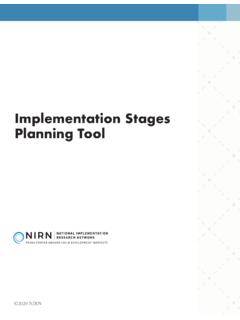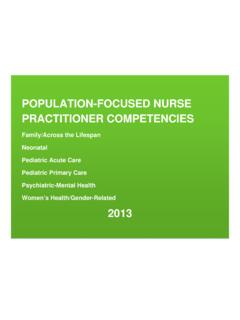Transcription of The Hexagon: An Exploration Tool - University of North ...
1 1 The Hexagon: An Exploration ToolHexagon discussion & Analysis Tool InstructionsSeptember 2020 2018 NIRN - University of North Carolina at Chapel Hill2 2018 NIRN University of North Carolina at Chapel Hill Metz, A. & Louison, L. (2018) The Hexagon Tool: Exploring Context. Chapel Hill, NC: National Implementation Research Network, Frank Porter Graham Child Development Institute, University of North Carolina at Chapel Hill. Based on Kiser, Zabel, Zachik, & Smith (2007) and Blase, Kiser & Van Dyke (2013).3 PROGRAM INDICATORS Program indicators assess the extent to which new or existing programs or practices that will be implemented demonstrate evidence, supports for implementation, and usability across a range of SITE INDICATORSI mplementing site indicators assess the extent to which a new or existing program or practice aligns with the implementing site along the following domains: population need, fit and capacity.
2 The assessment specifies suggested conditions and requirements for a strong match to need, fit and capacity for the identified program or discussion & Analysis Tool InstructionsThe Hexagon discussion and Analysis Tool helps organizations evaluate the fit and feasibility of implementing programs or practices in a given context. This tool is designed to be used by a team to facilitate discussion and ensure diverse perspectives are represented in a discussion of the six contextual fit and feasibility TO USEThe Hexagon Tool can be used at any stage in a program s implementation to determine its fit with the local context. It is most commonly used during the Exploration stage, the period when a site isidentifying possible new programs or practices to implement. Using the tool at a later stage can help diagnose implementation challenges related to contextual fit.
3 If the organization has an implementation team, the team can carry out this function for the AND IMPLEMENTATION SITE INDICATOR ALIGNMENT Each program indicator has a complementary implementing site indicator assessing similar constructs. For example, consideration of a program s evidence must be done with regard to an implementing site s need. Only assessing one of this pair would limit accurate understanding of fit and feasibility. Program and implementing site indicators alternate in the discussion guide to ensure comprehensive TO USE1. Develop a shared understanding of the broad need to be addressed, the focus population and the program(s) or practice(s) to be Review the discussion questions prior to meeting to ensure any data or resources that need to be reviewed for this discussion are available.
4 If appropriate, an organization may prioritize components for deeper Exploration based on the context and potential programs or practices. Regardless of which components will be prioritized, begin by clearly identifying and considering the broad need to be addressed. 3. Identify a team to participate in the discussion . If the site has an implementation team, that team can complete the assessment as part of their work. If not, identify key stakeholders internal and external to the organization who have diverse perspectives on the need and possible programs or practices to address the identified need. Suggested team members include leaders, managers, direct practitioners, representatives from the focus population and community TO USE4 EQUITY CONSIDERATIONSA ssessment of fit and feasibility is inextricably linked to considerations of diversity, equity and inclusion (DEI).
5 1 Disparate outcomes and community context cannot be accurately understood without acknowledging structural racism, marginalization and oppression. Using the Hexagon Tool with a race equity lens can prompt teams to consider potential impacts of the program or practice on the focus population and whether or not implementation of the program or practice could advance equitable outcomes for all individuals and families. Best practices for using this tool include: The focus population and community partners should be engaged in determining the broad need, as members of the discussion team and in the selection of programs and practices to be considered. The team conducting the assessment should either have a background in or be provided with training on DEI so that they can apply these concepts in their assessment of fit and feasibility.
6 All data (programmatic, fidelity, outcome, etc.) used to assess need and evidence should be disaggregated by race/ethnicity where appropriate, as well as by sub-population characteristics ( , gender, socioeconomic status, geography). 1 Diversity focuses on all the ways in which people differ and encompasses all the different characteristics that make one individual or group different from another. Equity is a condition that would be achieved if one s identity (race, gender, etc.) no longer was a statistical predictor of one s outcomes. Inclusion is authentically bringing traditionally excluded individuals and/or groups into processes, activities and decision/policy making in a way that shares power. Race Equity Tools Glossary. # DURING USE4. The team reviews and discusses the questions for each indicator and documents relevant considerations.
7 Extra space is included in each section for notes and additional questions identified by the team to address unique needs and After discussing each component, the team rates the component using the 5-point Likert scale in each Using the discussion notes and ratings, the team makes recommendations about whether to adopt or replicate the program or practice. While ratings should be taken into account during the decision-making process, the ratings alone should not be used to determine final Implementation costs Resources needed and available for implementationEVIDENCE Outcome, fidelity and cost effectiveness data Strength of evidence: for whom and in what conditionsThe Hexagon can be used as a planning tool to guide selection and assess the fit and feasibility of potential programs and practices for use.
8 It includes three program indicators and three implementating site Hexagon: An Exploration ToolNEEDEVIDENCESUPPORTSCAPACITYFITUSABI LITYFIT Fit with community values, culture and history Impact on other initiatives Alignment with other priorities of the implementing siteUSABILITY Well-defined program Adaptations for context and populationsSUPPORTS Expert assistance External resources for implementing sitesNEED Identification of focus population and subpopulations Use of multiple data sources and disaggregated data to understand needs and assets Community perception of needs and assets6 Today s Date:Individuals Participating in the Assessment:Facilitator(s):Identified Need:Identify the program or practice to be assessed. For each program or practice, write the numerical rating that best describes each indicator PRACTICE 1 PROGRAM/ PRACTICE 2 PROGRAM/ PRACTICE 3 Focus Population:Subpopulation(s): The Hexagon: An Exploration Tool71.
9 Who is the identified focus population? Are there subpopulations? If so, please What is/are the identified needs of these population(s)? What are the root causes of these needs? What are the identified assets of these population(s)?3. Was an analysis of data conducted to identify specific area(s) of need relevant to the program or practice? If yes, what data were analyzed? Were these data disaggregated by race, ethnicity, language and other characteristics specific to the focus population and subpopulation(s)?4. How do members of the focus population perceive their need? What do they believe will be helpful? How were community members engaged to assess perception of need?5. If the program or practice is implemented, what could potentially change for these population(s)?NEEDI mplementing Site Indicator8 RATINGNEEDI mplementing Site Indicator5 - Strongly Meets NeedThe implementing site has demonstrated a comprehensive understanding of how the program or practice meets the needs of the focus population.
10 The implementing site has included three or more data sources when conducting the needs assessment including administrative data and perspectives of staff, community partners and children, youth and families; and has disaggregated data to identify needs of specific and relevant - Meets NeedThe implementing site has demonstrated an understanding of how the program or practice meets the needs of the focus population. The implementing site has included two or more data sources when conducting the needs assessment including administrative data and perspectives of staff, community partners and children, youth and families; and has disaggregated data to identify needs of specific and relevant - Somewhat Meets NeedThe implementing site has demonstrated some understanding of how the program or practice meets the needs of the focus population.





